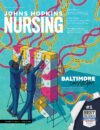Repeated studies have shown that open, green space can be good for the general health of communities, from combating obesity to preventing and treating asthma. And a neighborhood with trees and open green space is generally perceived as safer. But what if violence statistics do not necessarily back that up?
“Integrative Review of the Intersection of Green Space and Neighborhood Violence” by PhD student Gibran Mancus, MSN-Ed, RN, and Professor Jacquelyn Campbell, PhD, RN, FAAN, examines this perception vs. knowledge gap and what’s at stake: Worldwide, “an estimated 440,000 lives were lost due to violence in 2013 … [among those 15 to 34], homicide from assault was the third leading cause of death (11.5%) in the United States.”
Then there’s climate change: “Abnormally high temperatures are now a global phenomenon and have been associated with increased violence. [These] have the greatest impact on those who are socially disadvantaged and who experience disadvantage by environmental health inequities, especially African American women.”
Safe, green space can encourage parents to send their children out to play—helping their physical and emotional development, the authors note. And “walkability” can do the same for older adults.
There’s more research to do before policymakers can be persuaded that green space should be built into communities. The good news: “Nurses have the opportunity to lead the development, implementation, and evaluation of evidence-based interventions and policies addressing the inequality of quality and quantity of green space in the built and natural environment.”
Publication: Journal of Nursing Scholarship

